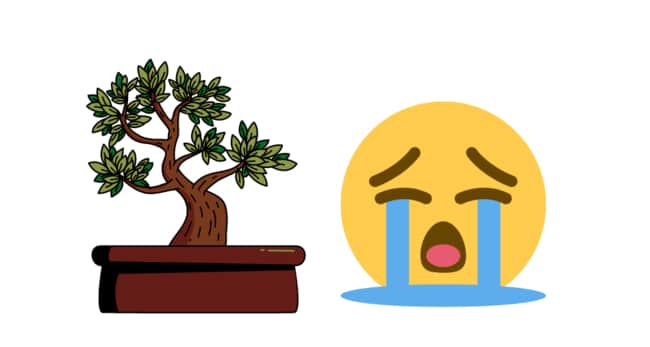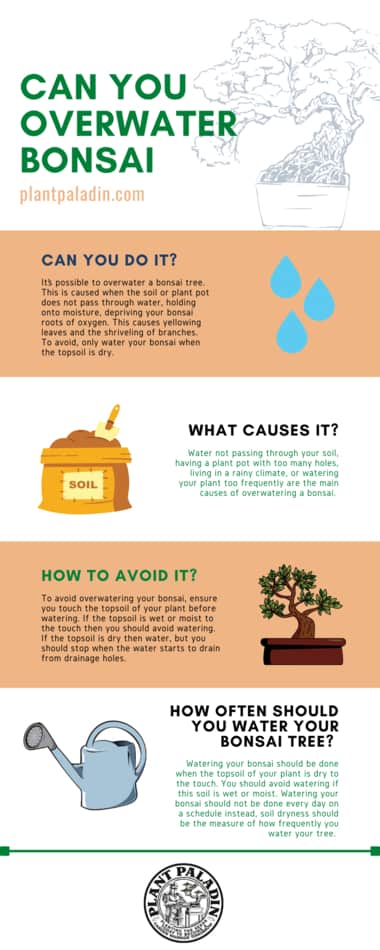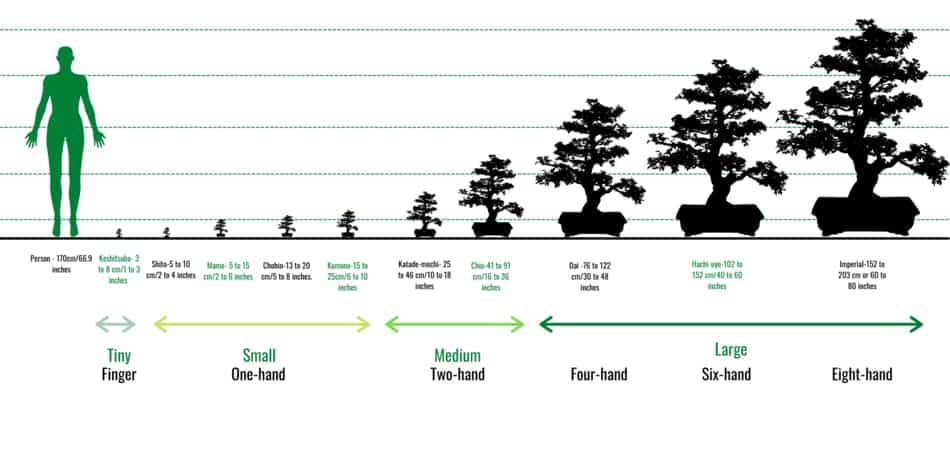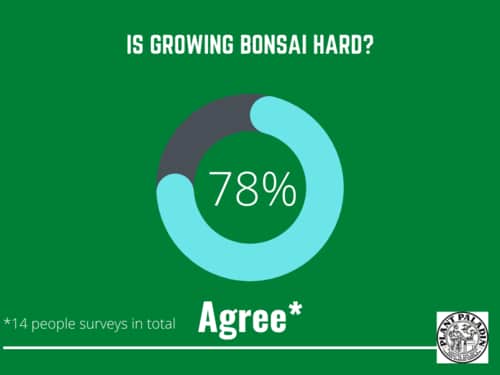This website is supported by its readers. If you click one of my links I may earn a commission. I am also a participant in the Amazon affiliates program and I will also earn a commission from qualified purchases.

One of the things that I should have taken into consideration before I started my bonsai journey was just how hard the whole process would be. I knew that bonsai wouldn’t be as simple as growing fruit or maintaining houseplants, but I didn’t know just how hard it would be. So why are bonsai trees hard to grow?
Bonsai trees are hard to grow for beginners. This is because of the constant maintenance, care, and patience required to successfully grow bonsai. It also takes years of pruning and growing before a new plant will start to resemble bonsai, and so can be frustrating if growing from scratch.
Bonsai trees then are often seen as one of the most challenging types of plants to care for.
So what are the main reasons that bonsai trees are hard to grow? And can anyone become good at growing bonsai eventually? Keep reading to find out more.
Just a quick heads up, over the past three years of running Plantpaladin, hundreds of people have asked for product recommendations. As such, You can find my favorite indoor bonsai tree here (link takes you to Bonsaiboy), my favorite outdoor bonsai tree (link takes you to Bonsaiboy), or have a look at all the products I recommend here.
Are bonsai trees hard to grow?
Growing and maintaining bonsai trees or better yet, growing and maintaining a bonsai tree from scratch, is one of the most valuable horticulture-based activities people can do.
It teaches you patience, care, and gets you outdoors which as we all know has tons of benefits.
That being said, I’d be lying if I said that growing a bonsai tree was easy.
If you are a beginner, I’d say that growing bonsai trees is quite hard if you have no experience in anything garden-related.
This is because of the following reasons:
Why are bonsai trees hard to grow
- The time it takes bonsai to grow
- Constant pruning
- Watering
- Light needs
- Patience required
- Disease
- Insect infestations
- Cost
To help break these down I’ve put them in a table below:
|
Why bonsai is hard to grow |
Explanation |
| Time | Bonsai can take 10-15 years to grow if no mistakes are made from seed to a small-sized tree. |
| Pruning | Bonsai require pruning a few times per year. It is also easy to prune your tree too much, destroying the nutrient flow. |
| Watering | Bonsai trees dry out so it is very common to underwater your bonsai tree. Over-watering your bonsai also will have detrimental effects. |
| Light needs | Most bonsai require at least 8 hours of sunlight during the summer months which can be difficult if you keep your plants indoors. |
| Patience | Trimming or pruning leaves, growing your tree for years instead of months all require a large amount of patience. |
| Disease | Fungal infections and mold infections like root rot are incredibly common in bonsai trees and can kill your plant if not maintained properly. |
| Insect infestations | Bugs like scale, aphids, and whiteflies are all incredibly common to nest in bonsai trees and pots so need to be maintained. |
| Cost | Most bonsai trees that have been grown for a few years are expensive with premium bonsai easily costing a couple of hundred dollars. |
Let’s explore these further.

Time
Easily the biggest reason why bonsai is hard to grow, especially for beginners, is the time it takes to see your hard work pay off.
If you are growing a bonsai tree from scratch – as in planting a seed yourself and wanting that to grow – it can take as much as 10 to 15 years to grow your plant.
This is because time is required to grow your plant as well as wire and prune it.
If left unchecked your plant would just grow like a regular tree.
As such then a lot of bonsai owners either give up on the process before they get to see the results they have worked so hard to achieve.
How to overcome
The best way to overcome this I found is to do the following
- Keep a bonsai journal – seeing the small progress you have made week to week, or day to day will help put things in perspective and make you realize that you are on a journey
- Buy a pre-grown tree – buying a bonsai tree from an outlet that is already 10 to 15 years old will make the process a lot easier than just growing one from scratch.
Pruning
Part of the fun around keeping bonsai is that you get to whip out your sheers and trim your bonsai.
That’s what I thought at least
The truth is that pruning has to be done quite a lot to maintain the health of your bonsai.
This is especially true if you want to create great bonsai ramification (link takes you to a post on what bonsai ramification is) or want to defoliate a bonsai (link takes you to post on what bonsai defoliation is).
What’s even worse is that if you trim or prune your bonsai incorrectly it can severely damage your tree. Impacting the nutrient flow of your plant.
This is especially apparent in more advanced deadwood techniques such as jin or sabamiki.
The whole process then can make maintaining a bonsai very hard.
How to overcome
To overcome the hardships brought about by pruning your bonsai do the following:
- Buy a bonsai tree just to prune – if you are new to bonsai, I would recommend buying a tree that you know you might mess up. This will teach you to proper form and technique and ensure that when you do prune a tree for real, you will feel a lot more confident.
- Attend bonsai classes – Attending a class in person or even online classes can teach you the basics to ensure pruning does not become an issue for you.
Watering
Like all plants, bonsai too will need a lot of water and most need a lot more water than normal plants.
What makes managing them more difficult however is that they often require different amounts.
For example, larger-sized bonsai will need a lot more water however will likely take longer to dry out.
Alternatively smaller bonsai are notorious for drying out easily – this makes keeping a collection of bonsai of varicose sizes very difficult.
What is even worse is that either underwatering or overwatering your bonsai trees can have adverse effects, such as aiding fungal infection, causing your leaves to turn yellow, causing leaves to fall off, root rot, or even worse death.

How to overcome
- Only water when the soil is dry – If the topsoil of your bonsai is dry then you know it is time to water your plan.
- Have a schedule – Keeping a regular schedule where you check your bonsai if they need watering will be crucial. Start at two times per day and then during warmer or dryer periods increase this to three times.
- Invest in the right soil – using a soil mix that has a lot of soil amendments such as sphagnum moss or akadama can work wonders in maintaining moisture levels, moisture flow, and aeration. I like to use a cactus soil mix.
Light needs
Another major factor that makes bonsai trees hard to grow is the light needs of these plants
During the summer months, most species will need at least 8 hours of direct sunlight per day for the photosynthesis process to take place.
Pair this up with the fact that most bonsai come from warmer climates such as the middle east, China and Japan mean that light is not something that can be ignored.
Not having enough light for your bonsai then is a common beginner mistake and failure to solve will cause your bonsai leaves to lose color, your branches to shrivel, and your bonsai to eventually die.
How to overcome
- Keep your bonsai outdoors during the summer – if you have a garden or outdoor space, during the warmer summer months keep your bonsai outdoors for at least a few hours every single day.
- Invest in a UV light – using a UV light if you keep your bonsai indoors and there is no access to windows or natural light.
- Winterize your bonsai – ensuring you either use a bonsai cold frame or winterize your bonsai effectively during the dark winter months will aid in your bonsai development.
Patience
We touched upon this earlier on but patience is another reason why bonsai trees are so hard to grow.
Not only does it take time to see the results of your work, but it also takes constant work to grow and maintain your bonsai.
For example, if you want to create a jin deadwood effect, or start a defoliation process on your tree, this will take hours of work – especially if you are new to bonsai.
This can lead to a lot of us getting frustrated and giving up att growing our trees.
How to overcome
- Practice mindfulness – practicing infinite patience and trying to live in the moment will work wonders, try to enjoy the experience of how long it takes to sometimes maintain bonsai.
- Come up with a schedule – if you know you have a big task that needs to be done for your tree such as defoliation, then set aside time every week to work on the big tasks. You might want to consider splitting these tasks over a few days to make them easier to do than take them all on in one sitting.
Disease
Sadly, due to bonsai being kept in tightly packed pots it’s very common for them to develop a lot of infections and diseases.
Not only will these be specific to the plant species but also include things like root rot, and white spots on bonsai leaves which are incredibly common.
These diseases and infections can spread meaning maintain any kind of outbreak can be incredibly hard – impacting the growth of a tree.
How to overcome
- Invest in a fungicide – most bonsai-specific diseases are because of fungal infections. Using a good bonsai specific fungicide will work wonders in cleaning that up
- Inspect your bonsai regularly – checking your bonsai for signs of white spots or mold every week, will help you stay in front of any potential diseases.
- Take your bonsai to a specialist – if your bonsai tree is infected then take your bonsai tree to a nursery. They usually have bonsai clinics that will be able to address any major infections in person.
Insect infestation
Another common occurrence that makes bonsai hard to grow is insect infestation.
Spider mites, aphids whiteflies, and scale all regularly attack bonsai and are particularly fond of removing the sap from your leaves.
This typically happens in the growing months of the summer meaning that if left unchecked, all the hard work you may have done to grow your bonsai can be ruined.

How to overcome
- Inspect your bonsai regularly – checking for signs of bugs, webs, or eggs in the topsoil are surefire signs you have an insect infestation. Check-in weekly during the summer to avoid.
- Use a washing-up solution – Using a mix of one tablespoon of liquid soap to 30oz of water in a spray bottle will work best to remove most bugs – failing that check out this blog post On removing bugs from bonsai.
- Invest in an insecticide – if your pest problem is severe then consider investing in an insecticide to kill the pests. Just be aware this can cause some nutrient damage to your soil – potentially changing its PH level.
Cost
Whilst some bonsai trees can be purchased for a relatively inexpensive amount, one of the major challenges to grow bonsai trees for amateurs is the price barrier to entry.
To get a decent Chinese elm beginner bonsai tree will cost at least $50 to $60 with more premium trees costing upwards of $200.
On top of this, other costs will need to be made such as the cost of pruning equipment, pots, and training courses which you will likely need.
Bonsai you see is a skill that has to be learned and unfortunately not something that you can just attempt by yourself and do these costs do add up.
How to overcome
- Go to places in person – Often a lot of bonsai nurseries will also host a training day. They even have free open days so time the purchase of your trees around these free training days.
- Use YouTube – YouTube has a wealth of free resources that can help you visualize specific techniques when it comes to creating bonsai.
- Use this site – A lot of the questions you will have about bonsai I also had about a year and a half ago so definitely check out some of the other posts on this site to further help your bonsai journey.
Are large or small bonsai harder to grow?
Smaller bonsai are harder to grow when compared to larger trees. Smaller fingertip-sized bonsai size classifications such as Keshitsubo will also sometimes require specialist pruning tools to trim branches without damaging the tree.
That being said larger bonsais still do pose their challenges to grow, often requiring more water and more room to grow with some bonsai owners opting to plant them into the ground to maintain their size.
On the whole, though smaller-sized bonsai such as will be much harder to grow and maintain.
For a full post on bonsai, size classification check out this post.

Is it hard to grow bonsai as a beginner?
It is difficult to grow bonsai as a beginner as a lot of the necessary habits required to be successful such as patience, maintenance and technique will not have been developed. Beginners and amateurs should consider practicing on older trees before growing their own.
That being said, practicing on older trees that are over 15 years old is exactly how I got started and made me a lot more confident in growing trees.
It taught me the basics of pruning, watering, and general maintenance.
I’d also recommend practicing on medium-sized trees as a beginner that you don’t have to worry about growing too much until you feel confident to move on.
What bonsai tree species are not hard to grow?
Chinese Elm bonsai is the perfect bonsai to grow as a beginner. They are very versatile and can manage not being watered or getting enough sunlight for longer periods. Chinese elms also grow between 12 to 36 inches per season meaning they are relatively easy to grow.
I’d recommend however as a beginner to get a small to medium-sized Chinese Elm to start with instead of a fingertip-sized Chinese elm.
This will help teach you the basics with a forgiving tree.
What bonsai tree species are hard to grow?
As a beginner, I would avoid any pine species. Whilst very pretty to look at these species are more unforgiving than the likes of elms and can sometimes be tricky to prune. Only when you are confident with beginner trees such as elms should you move on to pine species.
How to make bonsai less hard to grow?
Often when it comes to bonsai it’s not necessarily the amount of work that you have to worry about. It’s more the work in between the work, checking your plant for infestation,s maintaining regular pruning.
The following steps then work best to make growing bonsai easier:
- Check your bonsai three times per day to see if it needs water
- Keep your bonsai outdoors during the warm summer months to get enough light
- Try to replicate the climate of your bonsai origins. Tropical species might need bonsai greenhouses.
- Check your bonsai weekly for signs of insects or infection.
- Prune regularly during the summer months to shape
- Avoid advanced methods such as deadwood techniques until you’re comfortable with the basics.
It sounds simple but just doing these little things will make the world of difference when it comes to growing your bonsai.
I found that the best way to manage all of the above is just by keeping a regular schedule you can stick in your diary to follow.
What makes bonsai trees hard to grow
Lack of experience is the biggest reason why bonsai are hard to grow. Understanding the basics of pruning, watering, soil composition, and light care will ensure you will be successful at growing bonsai growing forward.
Doing so will help reduce the chances of more advanced issues too such as insect infestation or fungal infections.
Can amateurs be successful at growing bonsai?
Amateurs and beginners can be successful at growing bonsai trees. Following the basics, learning correct forms for pruning, watering, and light care as well as practicing on larger trees beforehand will greatly increase their chances of success in growing bonsai from scratch.
How long does it take to grow a bonsai?
It takes 10 to 15 years to grow a bonsai from scratch. These trees then will continue to grow in size if not pruned or reported correctly. Some bonsai trees are grown for over 100 years with some of the oldest being over 1000 years old.
For most bonsai owners however growing a bonsai from scratch is not that common with more options to maintain mature plants rather than growing their own
What do the experts say?
On a few recent trips to my local botanical gardens, I posed the question to one of the workers and this is what they said:
“Growing bonsai is hard, not because of the day-to-day maintenance but because they require a lot of attention constantly to grow, a lot of people give up on growing them from scratch and prefer maintaining larger bonsai” – Botanical Gardens
Now I also wanted to get the readers of this blog’s input as a lot of you are keen bonsai enthusiasts.
I ran an opinion poll and it came back with 14 results and here were the findings:

My top picks for the gear you will need!
So like I mentioned earlier, over the past three years of running PlantPaladin, hundreds of people have asked me for my recommendations on the best bonsai gear on the market.
Having spent thousands of dollars on bonsai items these past few years and tested at least 100 bonsai-specific products, I’ve listed my favorite products below – All of which I highly recommend and think you can get great value.
They can purchase directly by clicking the link to take them to Amazon.
Bonsai Tool Set: One of the significant challenges I’ve had is finding a toolset that was not only durable but didn’t break the bank. SOLIGT has recently developed a fantastic bonsai tool set that covers all the tools you need to trim, prune, and repot your trees. – You can grab it here.
Complete Bonsai Set: Many of you will want to grow your bonsai trees entirely from scratch, but finding the varicose seeds, pots, and other items in one place can be challenging. Leaves and Sole then have created a complete bonsai set that I’ve personally used that ticks all the boxes. You can grab it here.
Bonsai wire: The number of times I’ve run out of wire for my bonsai or purchased cheap bonsai wire that doesn’t do the job is embarrassing for me to admit. After a lot of trial and error, I found that using Hotop’s aluminum bonsai wire is one of the best options on the market. This can easily be used for both indoor and outdoor bonsai. You can grab it here.
This post was written by Fehed Nicass who has been passionate about bonsai for over 2 years. He currently resides in the UK and works in sales.
